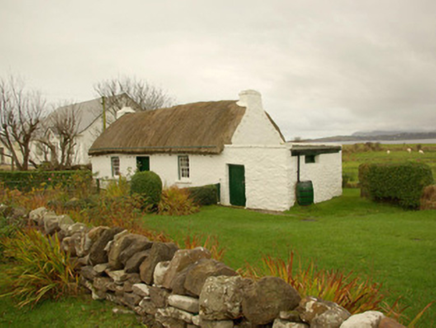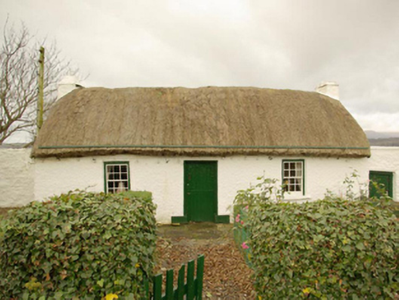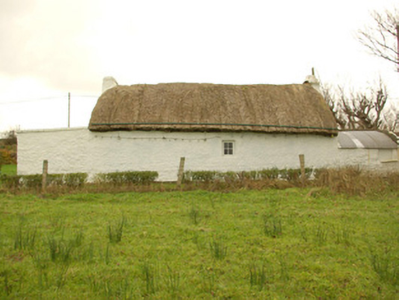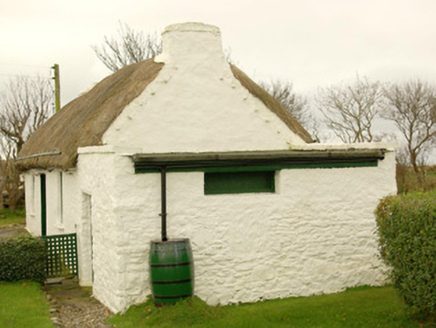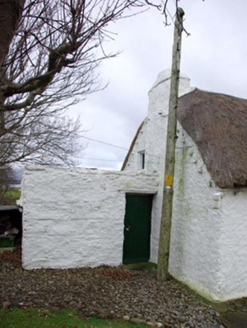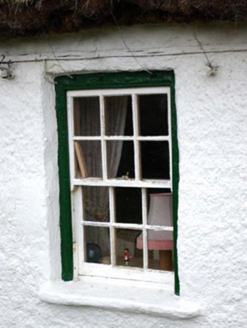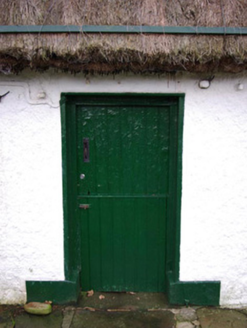Survey Data
Reg No
40909818
Rating
Regional
Categories of Special Interest
Architectural
Original Use
House
In Use As
House
Date
1840 - 1880
Coordinates
175366, 373327
Date Recorded
26/11/2007
Date Updated
--/--/--
Description
Detached three-bay single-storey vernacular house with attic level, built c. 1860, having single-bay single-storey extensions/sheds attached to either gable end (north-east and south-west). Pitched/domed thatched roof (recently re-thatched) having roughcast rendered chimneystacks to the gable ends (north-east and south-west). Timber, stone or metal pegs below eaves level for securing ropes over thatch to the main elevations and to the gable ends. Domed corrugated-metal roof to shed extension to the south-west gable end and flat felt roof over shed extension to the north-east gable end. Roughcast rendered and whitewashed rubble stone walls. Square-headed window openings having rounded painted (timber?) sills and with six-over-six pane timber sash windows. Single square-headed window opening to the rear elevation (north-west) having two-over-two pane timber casement window. Central square-headed doorway to the main elevation having plinth blocks to base and with battened timber double-door. Set back from road with garden to the front of site; bounded on road-frontage by dry stone wall. Altered single-storey outbuilding to the north-east having pitched corrugated-metal roof, rubble stone walls and square-headed openings with timber fittings. Located to the west side of St. John's Point with McSwyne's Bay to the rear, and to the south/south-west of Dunkineely.
Appraisal
This charming and well-maintained thatched vernacular house is one of the better surviving examples of its type in south County Donegal, and is a highly-appealing feature in the scenic landscape along St. John’s Point. Modest in scale, it exhibits the simple and functional form of vernacular building in Ireland. The retention of the early timber sliding sash windows adds substantially to its integrity and visual appeal. Of particular interest in the survival of the thatched roof, which is now sadly becoming increasingly rare in Donegal. The rounded roof is a typical feature of thatched houses located close to the sea in exposed areas in the north-west of Ireland, while the pegs to the eaves were used to tie ropes (and sometimes nets) over the roof to secure it against the prevailing winds as is the case here at Ballyederlan. The form of this building having chimneystacks to the south-east gable end suggests that this building is of the ‘direct entry’ type that is characteristic of the vernacular tradition in north-west Ireland. This building is also notable as it has not been extended along its length as is the case with most surviving vernacular buildings of its type in Donegal. This house represents a fine surviving example of a once ubiquitous building type in the rural Irish countryside, and is a valuable addition to the extensive vernacular heritage of County Donegal. The simple outbuilding to the north-east adds to the setting and completes the context.
